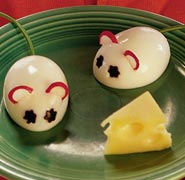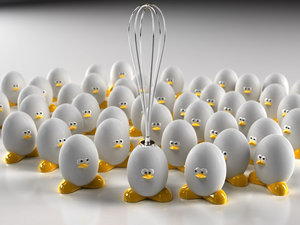 I know it's hard to believe, but I actually have some cooking skills, albeit very limited, I admit. One of my specialties is the hard-boiled egg, which is harder to cook than you might think. Most of the times, if you're not careful, the egg shell cracks during the cooking process and the inside oozes out and congeals into a gross goiter. Beurk! Or the yolk turns green and tastes like sand and sticks to the roof of your mouth.
I know it's hard to believe, but I actually have some cooking skills, albeit very limited, I admit. One of my specialties is the hard-boiled egg, which is harder to cook than you might think. Most of the times, if you're not careful, the egg shell cracks during the cooking process and the inside oozes out and congeals into a gross goiter. Beurk! Or the yolk turns green and tastes like sand and sticks to the roof of your mouth.With time, and after many, many disappointing results, I managed to develop the perfect recipe, which I was going to take with me to the grave. But this morning, lo and behold, I found in today's Le Monde a recipe by Christina Blais, of the Université de Montréal, that's similar to mine. Since the cat is out of the bag, I might as well post it here, as my contribution to the improvement of human civilization.
 Hardboiled eggs on a stick - Laos
Hardboiled eggs on a stick - LaosIl faut d'abord, avec une aiguille, percer un petit trou dans la partie renflée de l'oeuf pour permettre à l'air de s'échapper pendant la cuisson. Pas d'eau bouillante, car le blanc d'oeuf cuit à 64 0C ; au-delà, il devient caoutchouteux. Le problème est que le jaune cuit à 68 °C. Au-dessus de cette température, il devient sableux. Solution : cuire l'oeuf à 69 °C. "Mais cette température est presque impossible à maintenir dans une cuisine domestique", dit Christina Blais. Le compromis, à la maison, consiste à placer les oeufs dans une eau froide salée et à porter doucement à une première ébullition, couvrir et laisser reposer pendant une dizaine de minutes. On prendra soin, pendant la cuisson, de faire rouler l'oeuf dans la casserole pour obtenir un jaune bien centré. Le résultat est un oeuf assaisonné (par le sel), au blanc moelleux, bien équilibré autour du jaune pour obtenir de belles tranches, à la double texture idéale.

First, you must use a pin and pierce the shell at the round (not pointy) end of the egg, to allow air to escape during the cooking process. Do not let the water boil, since the white cooks at 64 degrees Celsius and turns rubbery at a higher temperature. The problem is that the yolk cooks at 68 degrees Celsius and turns sandy at a higher temperature. The solution is to cook the egg at 69 degrees. According to Christina Blais, «such temperature is impossible to maintain in a normal kitchen». The compromise solution, if you cook at home, is to put the egg in salted cold water which you will slowly bring to a boil. As soon as the water starts to boil, turn off the heat, cover the pot and let the egg continue to cook in that water for ten minutes. Blais recommands that you roll the egg around while it cooks so that the yolk is centered, but I find that the boiling water is already doing that rolling job for you, not to mention that the yolk centering doesn't really matter unless you intend to slice the egg for sandwiches, because really who gives a sh*t if the yolk is slightly off center? Anyhoo, back to the translation. The result will be a nicely seasoned egg (by the salt), with creamy white, equally distributed around the yolk to yield beautiful slices, and with perfect texture for both the white and the yolk.






2 comments:
If your boiled eggs yolk turns green and tastes like and and sticks to the roof of your mouth, then your cooking skills are not so great.
I did admit that my cooking skills are «limited». Fortunately, since I discovered the secret, my hard-boiled eggs no longer stick to the roof of people's mouth, or if they do, it's because they're so good, people are stuffing their face with them, gorging themselves and not taking the time to chew properly.
Post a Comment